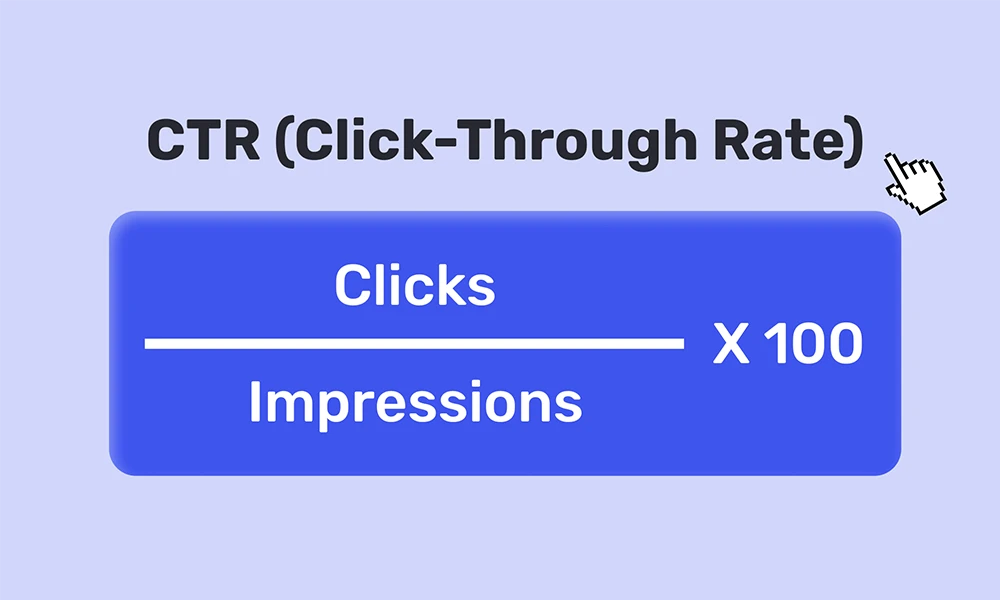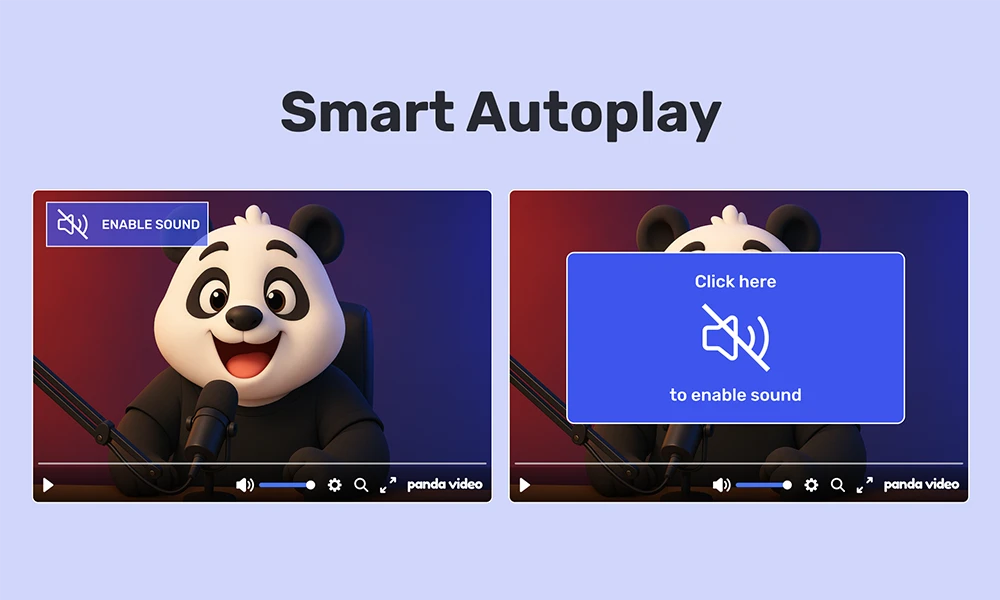Have you ever noticed how some videos on sales pages seem to magnetize clicks, while others go completely unnoticed?
Usually, successful videos share one thing in common: a higher click-through rate (CTR).
On landing pages and direct response campaigns, CTR is more than just a vanity metric — it shows how much your video truly sparks the viewer’s interest to take action.
But what makes a video achieve a high CTR?
In this article, you’ll learn:
- What click-through rate is and how it’s calculated.
- Why this metric is essential for those using VSLs or product demos.
- The 7 main factors that influence a video’s CTR.
What Is Click-Through Rate (CTR) in Videos?

The click-through rate (CTR) measures how many people clicked compared to the total number of video impressions.
In other words, it shows how effectively your video attracts interest from your audience.
Formula:
CTR = Number of clicks / Number of impressions × 100
Example:
If your VSL was viewed by 1,000 people and 50 clicked the button below it, your CTR is 5%.
That number might seem small, but on a sales page, it makes a huge difference — even a 1% increase can mean dozens or hundreds of extra conversions.
Why Click-Through Rate Is So Important in Video Campaigns
On a sales or product page, the video is usually the main persuasive element.
Studies show that a video can boost conversion rates by up to 66%.
But before it can fulfill that role, there’s one crucial step: getting the visitor to hit play.
CTR acts as an indicator of perceived value. When someone clicks, they’re essentially saying:
“This video looks interesting — I want to see what it’s about.”
If only a few people click to watch, the issue may not lie in the video itself, but rather how it’s presented.
7 Factors That Affect Your Video’s Click-Through Rate
Having a powerful VSL or a professional production isn’t enough — if the visitor doesn’t click play, all that effort goes to waste.
Here are the 7 most important factors that influence a video’s CTR.
1. Traffic Source
Visitors arrive on your page with expectations set by the ad, email, or creative that brought them there.
If the tone, promise, or visuals of your page don’t match those expectations, the video immediately loses relevance — and the click doesn’t happen.
For example: if an ad promises a “3-step simple solution,” but the visitor lands on a page with a neutral thumbnail that makes no reference to that promise, they experience a contextual mismatch.
What to do:
- Keep consistency between your ad and landing page by using the same keywords, colors, and tone of voice.
- Ensure the video thumbnail and title reinforce the ad’s promise.
- When possible, create page variations for different traffic sources, adapting the thumbnail and copy to each audience.
2. Page Headline
The headline is usually the first line your visitor reads — and often the one that convinces them to watch the video.
If it’s generic, confusing, or disconnected from the audience’s real problem, they won’t feel any urgency to click.
On the other hand, a strong headline builds context, curiosity, and a clear reason to watch — acting as a natural bridge to the video player.
What to do:
- Write short, specific headlines focused on the video’s main benefit.
- Make sure the text introduces the video topic and reinforces that the full answer lies just below, in the player.
- Use curiosity or transformation triggers, such as:
- “How [professionals in your field] are [achieving result] in just [short time].”
- “What no one told you about [video topic].”
3. Thumbnail
The thumbnail is the viewer’s first visual contact with your video, and its role is simple: make them want to click.
It’s like a store window — if it doesn’t grab attention, people won’t feel like stepping in.
Studies show that thumbnails featuring human faces, color contrast, and short text generate more attention and clicks.
What to do:
- Choose an image with a strong facial expression that conveys emotion (curiosity, surprise, enthusiasm).
- Use short text (no more than 5 words) emphasizing the main benefit or promise.
- Apply contrast between background and text to ensure visibility, even on small screens.
- Avoid generic or overly polished images. The more “real” it looks, the stronger the appeal.
4. The First Seconds of the Video
With the Smart Autoplay feature, the video starts playing automatically as soon as the visitor accesses the page — replacing the traditional thumbnail.
This strategy is designed to grab attention and increase the effective click-through rate through motion.
However, the effect can backfire if the video doesn’t capture interest right away.
If the opening is generic, slow, or disconnected from the promise made in the ad or on the page, the visitor will simply ignore it.
What to do:
- Ensure coherence between the page’s visual and textual promise. The first seconds must reinforce exactly what brought the visitor there.
- Use fast cuts, dynamic subtitles, or short on-screen phrases to capture attention even without sound.
- Highlight the main benefit or problem right at the start. Within 3–5 seconds, the visitor should understand why it’s worth watching.
- Avoid neutral or institutional intros, like long logos or intros — they break the rhythm and reduce initial curiosity.
5. Video Placement on the Page
Videos placed in secondary areas, surrounded by irrelevant information or low visual contrast, often go unnoticed.
Videos above the fold tend to have higher CTRs — but that’s not an absolute rule.
When the video appears in a strategic section, where the visitor already understands the offer and feels engaged, the likelihood of clicking play increases significantly.
What to do:
- Integrate the video into high-value content to create context and purpose for watching.
- Highlight the section visually — use white space and contrast so the player is easily identifiable.
- Avoid embedding the video in long or dense sections where the user might already be tired of reading.
6. Page Layout and Visual Context
Intense colors, excessive text, and multiple competing elements distract the eye and prevent the video from standing out as the page’s main focus.
Your video should look like the most important and natural thing to click on that screen.
What to do:
- Simplify the layout around the video player, creating visual breathing space.
- Use neutral colors or soft contrasts around the video to reinforce focus on the content.
- Avoid long text blocks or pop-ups near the player.
- Make sure the design guides the eye smoothly — from the headline to the video — without distractions.
7. Page Speed and Responsiveness
Nothing hurts your click-through rate more than a slow-loading video.
If the page is sluggish or the player freezes in the first few seconds, the visitor loses patience before even watching the content.
This problem is even worse on mobile — every additional second of loading time drastically reduces the chance that the user will watch.
A poor player experience can also hurt trust and brand perception, making your page look less professional.
What to do:
- Test loading times across different devices and connections to ensure the player starts instantly.
- Use a video hosting platform optimized for performance, especially for longer videos.
- Avoid overloading the page with unnecessary scripts, animations, or external embeds that slow it down.
How Panda Video Helps You Boost Your Click-Through Rate
When it comes to improving your video’s CTR, Panda Video offers exclusive features to help you maximize engagement and performance.
The two main ones are:
Smart Autoplay

Smart Autoplay automatically starts video playback the moment a visitor lands on your page.
The video begins muted, and the creator can customize the on-screen notification or icon to prompt the viewer to enable sound.
This feature makes your content dynamic and grabs attention instantly — increasing the likelihood of interaction.
A/B Testing
Panda Video also allows you to set up A/B Tests to optimize your video performance.
You can test different versions of your video, thumbnails, and configurations — all at once, on the same landing page.
That means you can identify which variations generate the highest CTR and conversions, using real audience data.
Frequently Asked Questions About Click-Through Rate in Videos
1. What’s a Good Click-Through Rate for Videos?
A “good” CTR depends on several factors, including the video type, industry, and audience.
As a general reference:
- 0–1%: Poor performance — your video needs improvement.
- 2–4%: Decent, but there’s room to optimize.
- 5% or higher: Excellent result.
The key is to keep optimizing — test different variables like thumbnail, title, placement, and video content.
2. How Can I Measure Video CTR?
Platforms like Panda Video and YouTube offer analytics that measure your video’s performance, including CTR.
In Panda Video, you can access the Analytics tab, select a video, and view the play rate, which reflects your video’s actual click-through rate.
3. How Can I Increase CTR Without Increasing Traffic?
Boosting CTR without increasing traffic is all about optimizing your video and page elements.
Here are a few quick actions to improve your click-through rate:
- Refine your thumbnail to make it more visually appealing and aligned with your video’s promise.
- Improve your title and page headline to emphasize the immediate benefit of clicking play.
- Optimize the first seconds of your video — especially when using Smart Autoplay.
- Adjust layout and video placement to make the player stand out.
4. What Are the Main Mistakes That Lower CTR in Videos?
Here are some of the most common mistakes that negatively impact your video’s click-through rate on landing pages:
- Unattractive thumbnail: lacks expression or fails to convey the video’s benefit.
- Promise–delivery mismatch: if the title or thumbnail doesn’t reflect the video’s actual content, visitors won’t click.
- Poor placement: video buried in a low-visibility or hard-to-find section.
- Weak intro: especially when using Smart Autoplay, where you only have seconds to grab attention.
5. How Can Panda Video Help Improve My CTR?
Panda Video provides several tools to enhance your video’s click-through rate:
- Smart Autoplay: automatically starts playback to increase engagement and clicks.
- A/B Testing: allows you to test thumbnails, versions, and settings for better performance.
- Detailed Analytics: track clicks, retention, viewer location, and more — giving you insights to continually optimize your results.




